We arrived at Fos on the border of Spain and set off up a verdant valley. At the end of a slow 20 mile drive up a track, increasing snow damage told of springtime avalanches. Finally a great 50 yard snowdrift lay in our way. It had slithered down the mountain, sweeping many trees in its wake and was clearly impenetrable. We were forced to make a multi point turnaround on the mountainside and retrace our steps.
| |
|
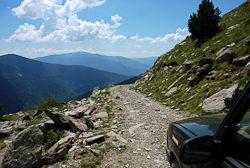 |
Then we drove to Vielha and started a long and exciting climb into the mountains which took most of the day. We drove up forest trails, river valleys and continued up beyond the tree line. Horses roamed free with their foals. At 6,000ft and snow was lying in pockets in sheltered cwms and ravines. After a great drive with several navigational challenges we reached our highest point at 7,000ft. There was a navigation mast at the peak and nearby a ski station, empty and unmanned at this time of the year.
A drove of horses had congregated together in the ski station and we guessed they knew something we didn’t; sure enough, a mountain storm was brewing. Lightning and thunder burst upon us without warning and was followed by severe rainfall. The trip back down the hill was a slithery affair.
We returned down to Espot and took refuge in a small hotel on the market square. Next day we left early and had a terrific drive up to 7,800ft, then down to a river crossing. Here we stopped for our Sunday lunch of soup, crisp bread and tinned mackerel fillets. Later we encountered more horses and several cows, their bells ringing rhythmically as they grazed the young grass. The rock-strewn track was scarred with deep ruts. A Land Rover is essential for this terrain.
We camped with some geologists at a site in Riberia which is a centre for white water rafting. We left next morning for Tirvia, but the Land Rover was hopping around like an agitated kangaroo, and it became clear we had suffered disintegrating suspension bushes. This was doubly irritating as I had renewed all these bushes just three days before departing. We abandoned our track and drove gently to the next town. Here a big jovial mechanic promised a full repair in three hours. In two hours he had sourced a new set of Land Rover bushes, fitted them and the repair was complete. ‘Big Jovial’ earned himself a good tip and we continued, only briefly delayed, our intended course.
|
Route up the Tor valley to Andorra. Satellite image |
We drove into a steepening gorge with no indication of an exit. Great soaring cliffs rose on either side and rushing water gushed between them. At the end of each blind gorge another smaller gorge would appear. We hoped to find a pass over or around these great mountains while we continued marvelling at the scenery.
| |
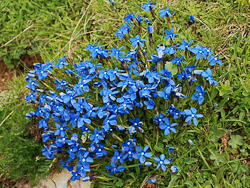 |
Eventually we reached a partly abandoned hamlet called Tor. Here the road ended and the climb began. The track was fair but steep and rocky. As we climbed higher and higher, the forest thinned giving way to upland pastures. We were now at 5,000ft. A large drove of mares nursed their newly born foals. At 6,000ft we were on open rocky terrain with isolated trees dotted around.
The land was spread with a profusion of meadow flowers, and here and there an outcrop of my favourite, the rare gentian with its vivid blue colour revealing itself so distinctly in the rocky hillside.
We were now at 7,500ft and a mere 5km from the unmarked Andorran border. We stopped by a pretty ravine and looked back down this picturesque valley with its horses, soaring landscapes and scattered wildflowers. This was one of the most delightful sections of the entire trip. We pulled out the ‘Kitmax TwinTop Tuckbox’ and settled down to a leisurely lunch of oxtail soup and French baguette, and a glass of wine to celebrate. We vowed to return one day.
We reached Andorra and camped in a welcoming, empty campsite. Next morning we drove on down to Andorra la Vella, the capital, and navigated through a maze of streets to our route. The journey was memorable for the large number of fuel stations en-route.
After leaving the town we drove high up a fine road and reached a summer leisure centre sporting boy's toys, quad bikes, karts and white knuckle rides for the children. We swept past the centre onto a muddy track leading up onto the prairie beyond. We set off across a great highland plain bordered by a mountainous bastion to the north and unscaleable pinnacles to the south.
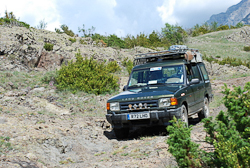 |
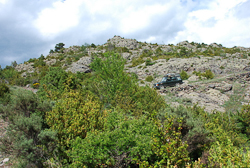 |
The track weaved the path of ages, following natural contours around precipitous valleys and mounting shallow cols between towering peaks. At every turn the view was spectacular.
As we descended we had a lovely forest drive with red squirrels playing in the trees, grazing cows and the occasional chamois. We diverted off the track and had a lunch in the dappled sunlight as cuckoos called, raptors soared and woodpeckers darted breathlessly through the woodland. We arrived at a ghost campsite where several caravans and tents were parked, but every one was empty. It looked like a scene from a horror movie.
We concluded it was a residential site where campers rent a pitch for the summer, install their camping equipment and use it just at holidays and weekends. We set up the tent and settled in. Later Raymond met the concierge who announced ‘we are closed’. Raymond explained we were already in residence and what was the fee? The promise of financial reward won the day and we camped alone and uninterrupted for a peaceful night.
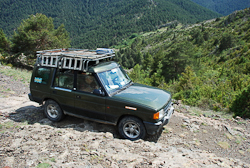 |
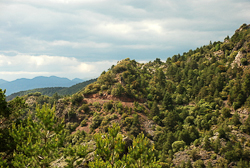 |
We completed our eastward journey just short of the Mediterranean at Collioure, turned west and reached Loarre and that wonderful medieval Castillo we had visited three years before. Valentina greeted us like old friends, booked us in to the campsite and cooked us a great dinner.
In the morning we set off along a ridge with the land falling away on either side. The view was spectacular. We passed a monastic ruin perched on a projecting cliff and reached the very pinnacle of the ridge and few miles further on.
The land fell away on all sides and the view was unforgettable – but greater than that was the sight of fifteen soaring gryphon vultures gliding on spread, motionless wings, 500 feet below us. This special site is the largest gryphon colony in the Pyrenees.
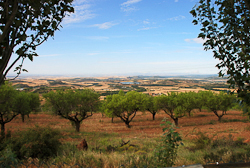 |
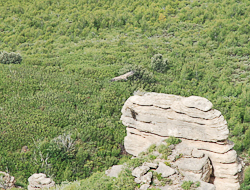 |
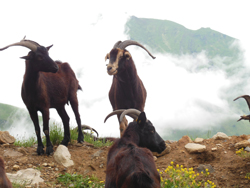 |
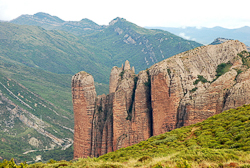 |
We backtracked down the ridge a short way and then descended into a mighty gorge. The walls got steeper and the river deeper. Far away a great split in the rocks indicated our only exit. Untold upheavals in prehistoric times had rent a deep chasm in the rocks and the river had been plunging through it ever since.
The track clung to the steep side of the gorge and it narrowed progressively. We drove on for over an hour. At the last 100 yards we were still high above the river when another deep ravine crossed our path, threatening to block our exit.
A temporary looking platform supported on a single column of stonework saved the day, and we were able to drive over the ravine and through the narrow gorge, almost touching either side. Once through this constriction, we swept out onto a spacious clearing bound by a sheer rock face to our rear and an unbroken vista of the river and farmland at the front.
The Loarre gorge was every bit as gratifying as before and a happy end to our ten-day off-road trip.
|